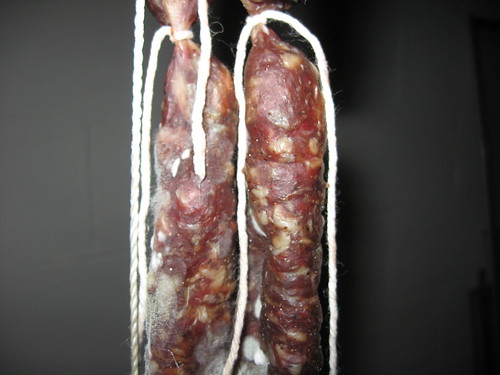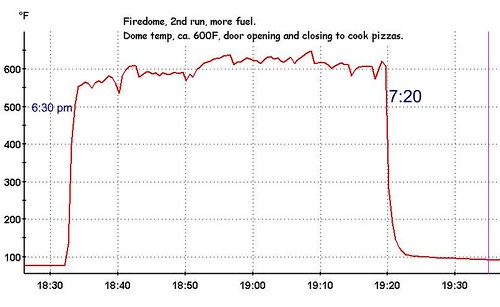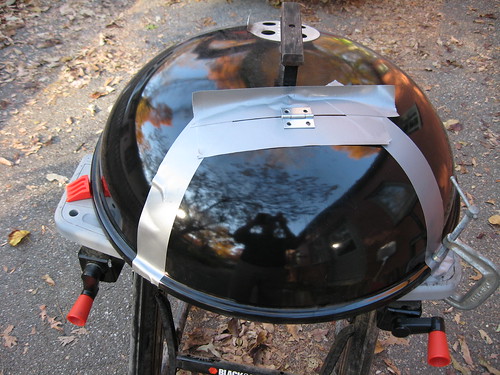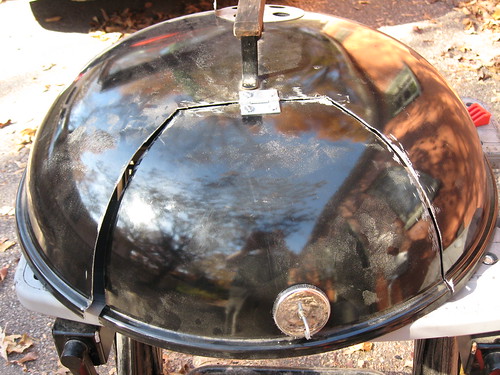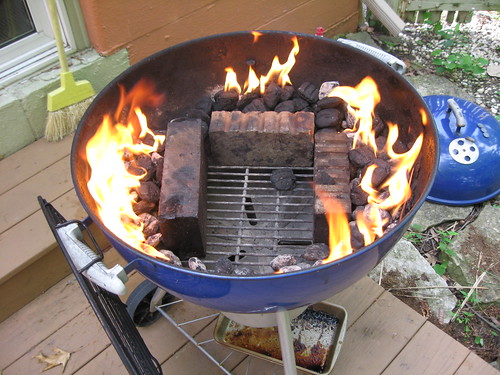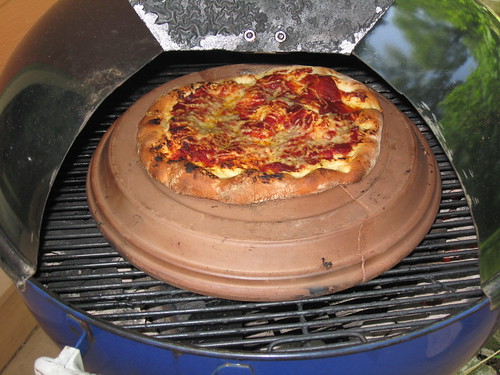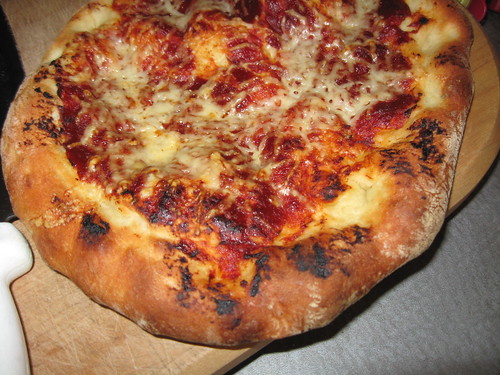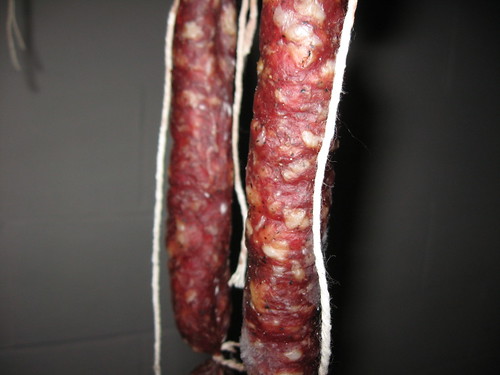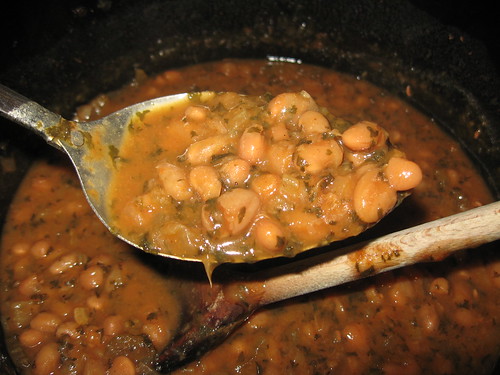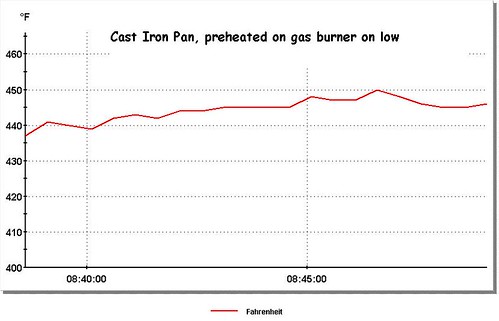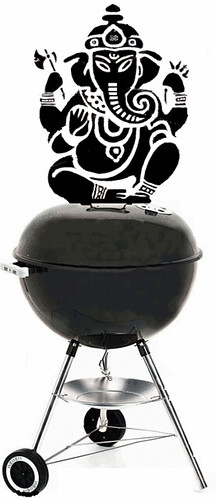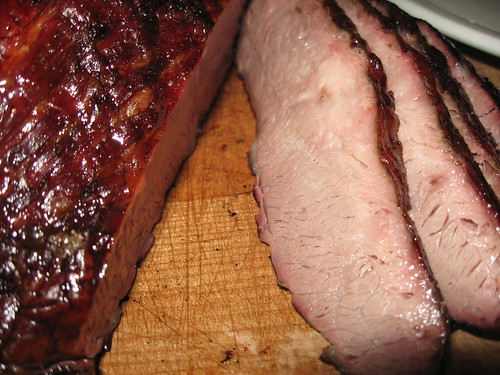Firm, fuzzy and green are they. Sadly, sausage, pepperoni, even sopressata aren't photogenic. This year's attempt at saucisson sec however, is going swimmingly. Next week I'll take 'em down, clean up the exterior a bit by rubbing them with a dry cloth and some rice flour, get the wife on the ready with 911 on the cell and take a taste (I honestly can't wait, I may go for it earlier). If I live through a day, we'll be feasting on them with a nice wine (no box stuff for these, thank you) and a crusty loaf, some fresh veggies and cheese for a celebratory feast.
In the next run, while the basement's still humid, I'll be repeating this with the wider casings.
6.20.2009
saucisson sec, day 18
6.17.2009
firedome 2nd run data
Cooking pizza on a Weber using the http://tr.im/firedome was based on 2 key requirements:
1. Using the kettle as an oven and getting a pizza in the "oven" without removing the kettle dome so as to maintain a constant (and high) temperature.
2. Getting a temperature distribution in the kettle/oven sufficient to cook the pizza uniformly; a necessary condition regardless of the oven used (conventional or grill).
This temperature profile, although a tad low, shows the relatively constant cooking temperature over an hour of cooking last night. I cooked 4 pizzas and opened the door of the firedome several times for each pizza. No significant dips; I'm giddy.
6.13.2009
Weber Kettle Mods: Firedome (pizza cooked on a kettle)
Welcome Weber-Stephen Products, LLC! Look around and enjoy your visit, please leave a comment to contact me.
Cooking pizza on the grill is filled with challenge and adventure. Mike is a pro and knows this area well. He and Andrew have finely honed the pizza on the grill by grilling the dough, flipping, topping and re-grilling, the final grilling melding all the flavors together.
Inspired by a friend's most decadent pizza oven ripping at 900+°F, I sought to make one of my beloved kettles into something more; an instrument that could cook pizza evenly. Although I failed to obtain my desired 800+ temps, the uniformity of cooking was an equally critical objective that was achieved.
Getting an old Weber Kettle lid ready for cutting out a "slice" to attach via hinge.
Made the cuts with a grinder and holes for the hinge with a drill. The jagged edges were buffed with a grinder attachment. I kept the tape on during the cutting to help keep the line and help keep the edges more smooth.
I placed the briquettes around the edge of the kettle in order to attempt to get a high temp high in the dome and not too hot at the base of the pizza. I tried once before with just the briquettes in the center and burned the pizza on the bottom before the top could get done. Also, I chose to light the coals once in place with lighter fluid (instead of a chimney and then arranging the lit briquettes).
I chose an inverted clay flower pot drip tray because it was elevated. This enabled the top of the surface to be more easily accessible from the lip of the Weber. The bifurcation of the surface is intentional. This clay was cast in a Shaolin monastery. The halves symbolize the yin and yang of humanity; the balance between eating from the Weber and drinking ale from the keg.
The coals were ready in about 30 minutes. I did a quick temp check. I had about 500°F in the high part of the dome and about 450°F on the clay surface. Not quite high as I wanted but went through with the test anyway. I used a basic pizza dough, a simple tomato paste and parmesan and olive oil topping (don't knock the smear of tomato paste, it's nice). I put the pizza on the clay and 8 minutes and 30 seconds later ...
Future?? I'm thrilled with the results. Perfectly cooked all around and no burned bottom. I think the relative temps of the dome and surface are what I was looking for with this configuration of briquettes. I would like now to get the temp up a bit. Maybe 700° or so in the dome - maybe lump? Suggestions appreciated via comments. For now, I'm just thrilled. Zach, Jim - podcast time??
More pics of the Firedome project on Flickr.
Other Firedome links:
- Firedome refinements
- Baba Ghanouj
- Early data
- Pita in a minute (youtube video)
6.08.2009
saucisson sec, day 5
I can practically taste the burgundy and bread to accompany this treat.
6.03.2009
Saucisson sec
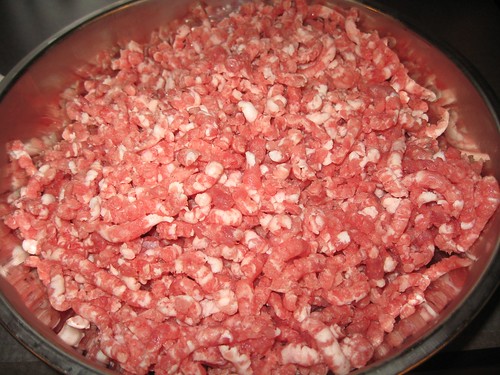
pork butt from Weilands, ground using a coarse die

seasoned, stuffed and pierced for drying

basement conditions, don't know why icon man is so sad
3 weeks 'til dinner
5.26.2009
16" x 16" Slate to bake on?
Having destroyed all my terra cotta tiles over the years, I decided to try a slab of slate to cook on. It's an unfinished sample I got at Lowe's yesterday for $10. Currently taking it through temperature cycles to see if it holds up. So far, I can see the layers on the side slightly separating. If it gets to some static state, it should be fine. If it continues to separate, it's back to the terra cotta.
5.23.2009
long video in process ...
I'm not dead, life is busy. Go to the ECJ post for an entertaining discussion.
5.12.2009
Kitchen Quickies
Been so busy, I just found two old cellphones wrapped in a plastic bag in the downstairs freezer. I have no idea why they're there. That's how busy we've been. But, dinner must get to the table. Some nifty quickies we've been enjoying. Just wanted to share:
• Black Bean Hummous 15 oz can black beans (undrained), tahini (1/4 C), salt (1t) olive oil (2T), ground cumin, salt (1 t), lemon juice (1 lemon), pepper, dry oregano, garlic (1 clove crushed) - processed and let sit in fridge for an hour, served with drizzle of oil with pita and fresh veggies.
• Salmon big salmon fillet (ca. 1.5 - 2 lb), skin side down on baking sheet, top coated with slather of greek yogurt (1 C), Dijon mustard (1 T), fresh dill (2-3 T), s&p, baked at 400°F for 20 min, let rest. Served with steamed new potatoes and salad.
• Brisket Chilli leftover smoked brisket (ca. 3/4 lb, diced), black-eyed peas (15 oz can, undrained), kidney beans (15 oz can, undrained), canned tomatoes (ca. 15 oz), chili powder (whatever you got), onion, garlic, paprika, s&p, etc. Simmer an hour or so. Served with really good quality corn chips.
• Brown Rice and Beans Not a mistake. This is amazing. Preheat oven to 350, saute in ovenproof 3.5 qt with tight lid (I use cast iron dutch oven) onions, garlic in olive oil, add 1.5 C brown rice, saute rice a bit, add 3 1/3 C water or stock, 1 can black beans, fresh ground cumin, salt and pepper and bring to simmer. Place lid on and put in oven for an hour. Remove, let rest and dig in. Serve with lime wedges.
Life has been going too fast, but we're still eating well. And, the phones are still in the freezer.
5.10.2009
The missing first video
Hit a snag recently. My breads have been lacking oven-spring. I watched my own vids to try to figure it out. Pretty sure I have it nailed. I'll be doing a nifty cumulative bread vid soon.
In the meantime, yogurt/dill slathered salmon is in the oven with smashed potatoes and salad for Mother's day (thanks Martha), for the only one who will tolerate my neuroticism. Happy Mother's day my love and to you Mom.
4.29.2009
Baked Beans
In a pinch, we eat Bush's Baked Beans. Not bad, but I hate the fact they're fat free. Fat free means they unnaturally remove the fat and add a shitload of sweeteners to get the right characteristics. In the process, they make a calorically-dense bean because they want to claim fat free. Bush underestimates the consumer.
Beans need fat. And, they shouldn't be as sweet as candy. I made a small batch for (hot)dog night a few days ago. Pretty easy.
Ever since Andrew told me of Paula Wolfert's Slow Mediterranean Kitchen, I've used my oven @ 200F overnight as a slow cooker. Ovens are so well insulated, it barely kicks on to maintain 200F. I used this to make my most delectable baked beans the other night and they were yummy.
Baked beans:
Cook a couple strips of bacon slowly (in ovenproof cookware) to render the fat. Eat bacon and drift into a momentary haze of ecstasy. In the hot fat, saute onion, pepper and celery, dump in 1/2 pound great northerns dry, add parsley, dry mustard, brown sugar, worcestershire (did I spell it right?), salt (ca. 2 t), pepper, ketchup and place in 200F oven for about 10 hours. Toss in fridge the next morning and reheat while dogs are cooking. Serve.
This preparation is ideal eaten near room temperature. Not too sweet or tangy. Vary quantities of ingredients to suit your taste.
4.15.2009
Cast Iron Skillet, low heat
When I cook bacon, I alter the (gas) burner real low so the bacon slowly renders its fat, becomes nice and crispy and the fat doesn't splatter all over the stove. It's a slow process that recently made me think about the heat source.
I've often wondered if a pan goes on a burner, does it constantly go up in temperature, or does it level off? Given that ignited natural gas must be over a 1,000F or so, I wondered what temp a skillet would get at vaious levels of gas on the burner.
I fired up a cast iron skillet and sandwiched a thermocouple probe on the surface with another smaller skillet to hold it securely on the surface. After a long pre-heating at a setting of 3 out of 8 on a 10K BTU burner, I was amazed at the stability of the temperature. The y-axis is expanded quite a bit and the duration of this brief, but not trivially short, test is over 10 minutes.
Seems kind of trivial once the data's in, but I couldn't figure it out before doing the expt.
This post should make my last 5 readers run for another blog.
Doctor Fire for a well-documented piece on flame temperature determination.
4.12.2009
Where's the first video, ya bastahd?
The baguette has been a significant focus in my life for literally decades. It serves us not only as a daily bread, but is more about community. Food to share - with friends and family. The "recipe" for it is the motivation for this site. There are no bread recipes as far as I'm concerned. Bread, while it may only take a few minutes to toss together, is not a recipe, it's a way of life.
Enough of the philosophical, just had to justify another in an infinite series of posts on my obsession.
The baguette plays out in 3 acts. All 3 change gradually over time as experience is accrued. Currently, I'm concerned with modifications to act 3. The humidity applied during baking. After talking to Andrew last night, we feel the initial humidity as gleaned from the early pages of Reinhart's Baker's Apprenctice is more critical than we may have thought.
I've routinely humidified my preheated electric oven with 1 cup water tossed in at the beginning and occasionally, I dabbled in moistening the exterior of the loaf itself. I'm in the process of configuring alternative conditions. I'm now trying the baking in the lower third of the oven (as usual), beneath the perforated aluminum baking sheet is a half sheet baking pan with 1 cup of water (placed in it a couple minutes before baking) and the sides of the oven doused with a stream of water just as the loaf goes in. Too much for words, this will show up in a future video if it works. Thanks for the talk last night Andrew. Someday we'll get that voluminous, airy inside, razor-sharp crusted baguette.
And the first act video? Soon, I promise. It's the only act that never changes.
ps, According toWikipedia and the formula for volume of a cylinder, the density of a French baguette should be 10 mL/g (that is not a mistake, typically density is given in units of g/mL, but the inverted dimension is a more useful metric). My loaves this morning were about 4.4 mL/g - loooong way to go. I think I actually created an environment that was too humid!! Very useful though. Going in the wrong direction for volume is useful too.
4.04.2009
New Pizza Recipe/Video - get ready (to Flop)
Some weeknight, I'm going to make a 12" pizza with nice bubbles and a beautiful airy crust. If you want to follow along, put 2 cups flour, 1 cup water, 1/2 t dry yeast (any kind) and 1 t salt (regular or 1.5 t kosher) in a container, mix into a ball, don't bother kneading and toss in the fridge until about Tuesday night. It's gonna be awesome.
Update
I filmed the entire thing and the final pizza was too moist inside. The slack dough was simply too wet. Even cooking in an amply preheated 550-deg-F oven, it was still under done in the middle despite the nice bubbles on top.
I'm posting the vid because the method will be identical and I'll simply replace the dough recipe. Sorry for wasting your flour all. Agony of defeat hurts. If you feel like losing 8 minutes of your life you will never, ever get back, here it is.
3.24.2009
A Shrine to the Almighty Weber
Behold, the godly force guiding my kettle's thermal control. I had a stellar brisket run this weekend. I've never done one very well before. I cooked my 4 lb baby fat side up for 12 hours at 200°F, then turned it up a notch and cooked it 5 hours at 240-260°F to a finished internal of 185-190°. I wrapped it for an hour while I clobbered the family in Scrabble. Zag is a word you know.
The brisket was sublime. After being sliced, it seemed to taste more like roast beef than brisket. Not fork tender, still had some texture; damn good. I'm a dedicated pulled pork fan, so my palate for brisket isn't too well developed. I think it was good though.
Too bad the dog's stomach didn't tolerate it so well. I will not provide details. Below is a pic of the succulence that was the highlight of our dinner.
